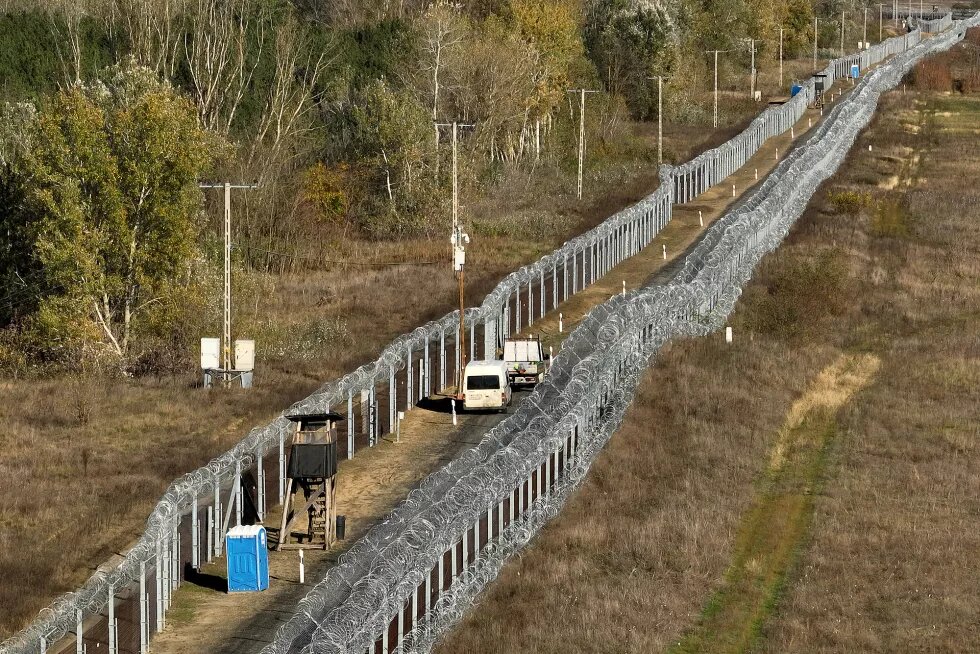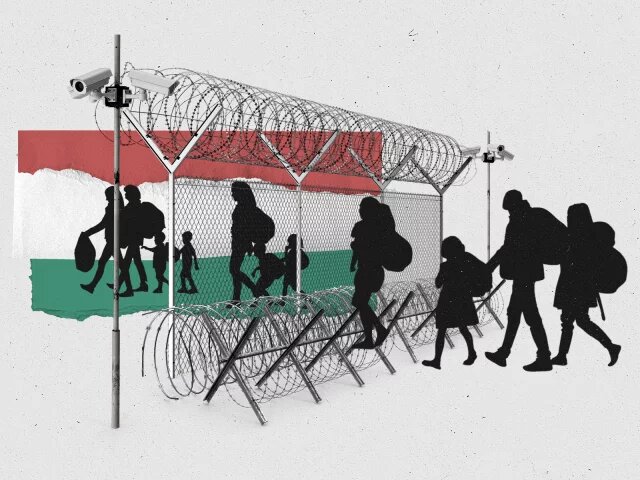
In Greece, Hungary and Poland, there are people who believe fences protect them from external threats, in whatever form those threats might come.
Along the borders of each of these states, huge sums of money have been spent to keep out those who would seek asylum; the fences differ in size and design, but they have one thing in common – they are more a political symbol than an actual barrier.
A closer look at the fences, at the people who man them, who live alongside them, who try to breach them, gives the lie to government claims that fences stop migration. They don’t; they just make lives more miserable.
In Hungary, people living on both sides of the border are concerned: they want to help migrants and refugees, but they’re fed up with hearing gunfire in the woods as smugglers fight for territory. None of the locals think the fence is effective, especially without proper legislation.

“Now, it’s calm,” said Attila Balog, a resident of Asotthalom on Hungary’s border with Serbia.
“Since the shootings happened and the Serbian border guards took action, hardly any people have come from Serbia. What the Hungarian government has failed to do for years, the Serbs have done in no time.”
The ‘shootings’ were armed clashes between increasingly well-armed smuggling gangs, some of which enjoy ties with corrupt police officers; Serbia unleashed a massive police operation, but, said Balog, “There are still attempts to get through the fence, as we know from the new pieces of trash in the woods.”
“But the volume of migration has certainly decreased, and the route has changed and branched slightly.”
Some of Asotthalom’s 4,000 inhabitants have left, fed up with the fact their village has become a conduit for migrants and refugees trying to reach western Europe.
The village is surrounded by forest and many of its residents live off farming. Balog’s own farm is just four kilometres from the border. He has installed a video camera to monitor his property, which migrants and refugees often pass. “One night, I counted 155 people,” he told BIRN. The fence hasn’t changed much, he said.
“Initially, I was happy with the fence. I think it mitigated migration, but without proper legislation, it’s worthless.”
“Migrants found the weak points, and people smuggling groups appeared. When everyone else talked about an impenetrable and solid fence, we who live here saw how easy it was to get through. If someone walks thousands of kilometres, a fence that says ‘go away’ in their language will not stop them.”
The shootings Balog mentioned occurred in late October 2023 in the Serbian border town of Horgos. Three people were killed.
After the deaths, and with elections looming, Serbian police carried out a number of raids around the border. Migrants and refugees were rounded up and bussed to southern Serbia; some smugglers were arrested, others melted away. Once the elections were over, the police presence returned to normal.
People on both sides of the fence are concerned.
“It’s not simple, it’s not black and white,” said Ida Boka, a freelance journalist and activist on the Serbian side. “Many people want to help, but no one likes to hear gunfire from the woods or armed men marching outside their house. Understandably, people are afraid.”
Boka lives in Donji Tavankut since 2019 [Also-Tavankut in Hungarian], 30 kilometres from the town of Subotica. The village is surrounded by dense forest. At first glance, the fence behind it looks imposing, almost threatening. But the closer you get, the more the gaps become apparent, as does the absence of border guards.
“There was also fear in 2016, but not to this extent,” Boka told BIRN. “There is so much negligence, everyone is left alone. Migrants are left at the border without help, work or prospects for a better life. The locals are on their own, and there is no open communication by the authorities on how to live with the migrants. The same happened after the Balkan wars [of the 1990s], people didn’t know how to live together.”
“It is simply dangerous to go into the forest” – a local activist on the Hungarian Serbian border si - Birn Balkans
 Watch on YouTube
Watch on YouTube
Not ‘100 per cent’ defence: Orban
The Hungarian government began building the four-metre high fence along its 175-kilometre southern border in June 2015. It has been reinforced several times since then, with a second row, motion detectors, megaphones, watch-boxes and, in some parts, electricity.
Despite the scale of the undertaking, it is still not known precisely how much it cost or which companies were involved.
Officially, the army and the Hungarian Prison Service, BVOP, were responsible for the construction. Soldiers, inmates and public workers built the fence, and the prisoners produced the basic materials, the government says.
In the summer of 2023, Deputy Interior Minister Bence Retvari put the cost of protecting Hungary’s southern border – not just building the fence – at 650 billion forint, roughly 1.7 billion euro. Asked for more information, the interior ministry sent BIRN a web link to a press release which cited the same figure of 650 million forint but not the cost of the fence alone.
Hungary’s leaders seem content. “The fence is good, it’s necessary,” Prime Minister Viktor Orban told parliament in July 2023. “The defence is certainly not 100 per cent, but it’s successful.”
In November, Orban’s political director, Balázs Orban, suggested that Croatian President Zoran Milanovic should try to cross the Hungarian-Serbian border illegally if he thought the fence was ineffective. Milanovic had said crossing the fence was like walking into an amusement park – anyone could get through.
Milanovic hasn’t tried, but others have, and they have succeeded.
A Hungarian intelligence report published in early November acknowledged that the fence had become vulnerable due to constant damage, especially around Asotthalom: last year, 3,357 repairs were made on the section in Csongrád-Csanád county, of which Asotthalom is part.
Barnabas Heredi, a ranger from Asotthalom, said that between 1,000 and 2,000 people tried to breach the fence every day, before the Serbian police operation “put them off”.
“In November, only up to 100 people a day were trying.”
Heredi said that crossing the fence is not difficult. There are cameras, but there are also blind spots the cameras can’t see, and there are guard posts without border guards.
In 2017, he said, there were guards every 50 metres. Now they only drive between the two rows of fencing. Smugglers monitor the weak points and when the guards swap shifts, he said.
Asked about the number of police officers and border guards stationed on the southern border each year from 2016 to 2023, the National Police Headquarters told BIRN: “In recent years, the number of border police forces on the southern border has always been adjusted to the operational situation.”
“Dozens of people can pass through every second” – a ranger on the Hungarian Serbian border fence - Birn Balkans
 Watch on YouTube
Watch on YouTube
Hungarian asylum system broken
A lack of official data means it is hard to know how many people get through the fence. The Hungarian Central Statistical Office, KSH, has figures on the number of asylum seekers, but in the case of Hungary this has nothing to do with how many people cross its borders.
From 2020, people seeking asylum in Hungary must submit their statement of intent to the Hungarian embassy in Kyiv or Belgrade, but, according to rights groups, the system does not work in practice.
Since 2016, Hungarian police officers have been under orders to escort people back to Serbia without a hearing if they do not hold valid papers.
“If someone arrives in Hungary by plane without a visa and wants to seek asylum, they are taken to the Serbian border, pushed back and shown the way to Belgrade,” said Aniko Bakonyi, Director of the Refugee Programme of the Hungarian Helsinki Committee, HHC. “If they’re lucky, they won’t get beaten up.”
According to the HHC, pushbacks are becoming more and more violent.
“There is no functional asylum system in Hungary,” said Bakonyi. “People seeking protection are falling into the hands of smugglers.”
The Global Initiative Against Transnational Organised Crime, GI-TOC, estimated the market value of smuggling migrants and refugees in the region in 2020 at 35-50 million euros.
“With more than 100,000 migrants crossing Serbia in 2022, the market value must be much higher now,” said Sasa Djordjevic, GI-TOC field coordinator for Serbia and Montenegro. “It’s no wonder that different smuggler groups fight each other.”
A new pattern has been observed at the Bulgarian-Serbian and Hungarian-Serbian borders, Djordjevic told BIRN: a growing number of migrants are using fake documents, indicating greater involvement of organised crime.
He said it was highly unusual that the Hungarian government had decided to release so many people smugglers – 2,021 smugglers in 2023.
A political symbol
In an interview in 2017, Balazs Orban, the prime minister’s political director, said: “The border fence is both a political symbol and an effective, practical defence tool. It is a symbol of nation states confronting the mess of globalisation.”
Despite the controversy surrounding the fence, government officials still support it. The fence always comes in handy at election time.
“It is in the interest of the Hungarian government to keep migration and border protection on the agenda,” Zsolt Lázár, a defence and security expert, told BIRN. “It is an excellent domestic policy product to show that they can protect Hungarians.”
The big question is, how long will it really work? According to Hungary’s Political Compass 2022, a survey by Policy Solutions, 56 per cent of Hungarians do not consider it acceptable for people of other cultures to move to Hungary. That’s a big proportion, but it’s down on the 68 per cent recorded in 2018.
“This fence makes no sense,” said Boka, on the Serbian side. “If someone wants to cross it, they will. If someone has money, they will go with smugglers; if not, they will try alone. It doesn’t work. But what does it even mean for it to work?”
“We don’t feel that the fence has stopped migration” a local activist on the Hungarian Serbian bo - Birn Balkans
 Watch on YouTube
Watch on YouTube
This article was first published on 29 February 2024 on Balkan Insight.
It has been produced with the financial support of the Heinrich-Böll-Stiftung Thessaloniki.
Its content is the sole responsibility of the author and does not represent the Foundation’s views and opinions.









